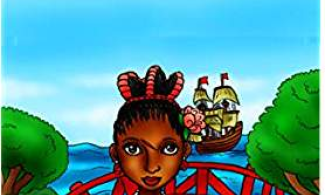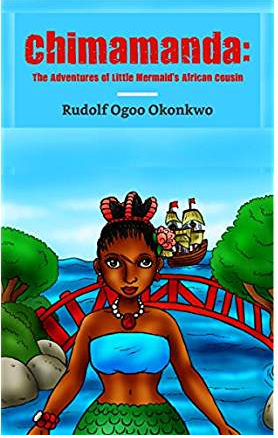
A Review of 'Chimamanda: The Adventures Of Little Mermaid's African Cousin' (2018 ) By Rudolf Ogoo Okonkwo

PART I
“Animal Farm: A Fairy Story” was the original title of George Orwell’s famous book, one of the top-100 English-language novels of the 20thcentury. It is not a fairytale but a political satire of the Russian Revolution. Rudolf Ogoo Okonkwo’s “Chimamanda: The Adventures of Little Mermaid's African Cousin”leaves the reader with no doubt that it is a fairytale. Is it? He lures the reader to that thought with the subtitle—as did Orwell until an American publisher yanked off the pretentious part. If Okonkwo’s “Chimamanda”is a fairytale, then he had 7-to-14-year-olds in mind. To an adult reader, “Chimamanda”is a cultural cruise and an educational excursion. To appreciate the knowledge-padded pages, one must open the mind and think outside the fairytale paradigm.
The title of the book opens a new vista of the name, Chimamanda. It is currently one of the popular names for Igbo girls in the last decade or so, a direct result of the literary successes of the “Americanah”author. Okonkwo translates the name as “my destiny won’t disappear” (p32), which is the main idea of the book: The young and beautiful mermaid with a facial scar lives to realize her destiny despite odds. The scar was caused by the explorer, Scottish surgeon Mungo Park, who killed her father and brother, the mermen of her River Niger dynasty. In search of a cure, Chimamanda becomes a liberal intellectual, who interacts with humans and pythons as a meddling mermaid and as a clumsy human, marries an in-confluence River Benue merman named Nosa, and establishes possibly the last dynasty of mermaids in River Niger.
In Igbo theosophy, “chi”conveys destiny because it is the godly guardian that follows every human being from the cradle to the coffin. So, the idea that Chi will not fail (“chi ama nda”) also conveys that one’s destiny cannot be derailed—if one walks with “chi”—an equivalent of angel in Western religious thoughts. In fishing for a magical cure for the scar among humans on the banks of River Niger at Onitsha, Nigeria, Chimamanda charts the footpath to her destiny.
A young reader who has read or watched Hans Christian Andersen’s “The Little Mermaid” will breeze through the book. “Chimamanda is of the 20thgeneration with little mermaid, Ariel.” (p29) It is indeed a story of mermaids in an African setting. Okonkwo makes it obvious that the mermaids are a race of aquatic beings zooming across the waterways of the world; the River Nile mermaids attend a naming ceremony in River Niger. (p32) Similar stories of mermaids have conditioned young readers to suspend human reality and stick their heads in the colored clouds of talking animals, fire-breathing dinosaurs, marine mermaids, wild and wicked witches, Harry Porter magicians, etc. To these young minds, the concept of African mermaids is easy to grasp. Chimamanda’s story streams seamlessly with soft steams of skilled storytelling. Mermen are not common in African stories; probably for this reason, Okonkwo kills them off from the onset and only brought back Nosa to continue the dynasty and to complete the destiny. (p79)
PART II
To an average adult African, mermaids are real river beings; mythological or not, strange beings thrive underwater. Biblical Jonah refers. Many Nigerians know them as “mamiwota.” The water maidens possess the power to pop out of their water dynasties and thrive temporarily among humans. Therefore, it is common to use mermaids in an endearing expression (“She is as beauty-full and fair-complexioned as a mamiwota”) and in a derogatory docket (“She is a mamiwotaseeking to drag a weak man to his demise.”) In some parts of Igbo nation, especially among the riverine folks, people celebrate mermaids during Owummiri festivals for their magical powers to do good or evil, just like every other deity or being known to the Igbo.
No matter on which side of the readership rank one belongs, the reader will need a further education to appreciate fully the depth of Okonkwo’s “Chimamanda.” A popular legend has it that the goddess of River Niger had to be bottled before the Asaba-Onitsha Bridge could be built over River Niger. Another legend credits Dr. Nnamdi (Zik) Azikiwe, the American-educated, first president of Nigeria, with the superhuman bottling of the goddess before the bridge, which reportedly took many lives, could be completed. Okonkwo found a way to weave the story into the book. Guess the name of the great medicine man who made the bridge possible by bottling the widowed and uncompromisingly conservative mother mermai: Zik! (p11)
In so short a book (only 81 pages), Okonkwo brought in many myths that are still believable in some quarters. For example, the myth that the South Atlantic hurricanes are a result of chattel slavery is still pop in urban legends. In Okonkwo’s book, the mermaids of Madagascar are still protesting the Mungo Park people (European colonists) for their callousness in enslaving fellow humans of Africa. (p26) As if to get the reader’s head off the funk of fairytales, just as one is about to buy into them, Okonkwo pin-punctures the myth.
Interestingly, some myths in the book are credible. One may wonder why the villagers do not kill Chimamanda when she retransforms into a mermaid on dry land. In Igbo culture, killing anyone is an abomination against Anị, the Earth deity. Specifically, elders enjoin the children of humanoids not to oppress the scions of spirits (mermaids, in this case), and appeal to scions of spirits not to oppress children of humanoids. So, when next you hear a kolanut consecrator pray, “Nwamụọ egbune nwammadụ; nwammadụ egbune nwammụọ,”you must remember the villagers of Ngo-Ndam in Nnobi community and Chimamanda, the mermaid. (p75)
In addition, Chimamanda’s crime is a retaliation of sorts; it avenges that humans once locked her mother in “a bottle of Coke from [Zik’s] goatskin bag” to build a bridge. (p58) Therefore, Chimamanda probably believes that bottling a little village girl, Ify, until she could figure out the mystery of python eggs is acceptable. It has become obvious to her that pythons, sacred serpents with spiritual significance in the area to this day, are totems whose eggs possess powers worthy of knowledge. In a world of balance and equity, the mermaid does what humans have done to her mother to get a bridge for freedom of passage. In the process of probing the potency of a python egg, she regains her own freedom of passage back to the waterways of River Niger.
PART III
Okonkwo takes the reader on a tour of European colonialism, how transatlantic chattel slavery began (with a memo from Friar Bartolomé de la Casas, Bishop of Chiapas, to Holy Roman Emperor, King Charles V), the colonial carving of, scramble for, Africa at 1884 Berlin Conference, and the abolition of slavery—which began with Olaudah Equiano’s narrative of 1789 and came to a head in America with Igbo Landing in 1803. Indeed, the Igbo slaves who mass-drowned rather than succumb the tyranny of slavery sang that the Omambala river brought them to America and should take them back. This River is major tributary of the River Niger.
“Chimamanda”is profound to a careful observer and irreverent in parts to a casual reader. A closer study of the scripts reveals that Okonkwo gave the work serious thoughts. From intellectual Chimamanda, we read this gem: “To live, I have to think. To think, I have to question. To question, I have to doubt. To doubt, I have to observe. By observing, I discover. By discovering, I live.” (p42-43) This mantra drives Chimamanda to make peace and to save the River for man and mermaids. Okonkwo must have struggled with watering down the book for a younger audience and challenging adult readers to revisit African history, to educate themselves more, and strive to make more sacrifices for the good of all beings. He accomplished both: entertain the young and challenge the old. Very few folks I know can explain the book without reading up on snippets of Okonkwo’s litter of letters packaged in a compact, ordered, and supposed fairytale.
“Animal Farm” came as a contemporary satire; I believe that “Chimamanda”will eventually stand on its own. The uncommonness of the name fits into the narrative that it must have taken the spirits to inspire the uncommon and beautiful name. Regardless, it satisfies the saying that what one is created to be is inviolable; hence, destiny cannot disappear.
Orwell wrote “to fuse political purpose and artistic purpose into one whole.” In “Chimamanda,”Okonkwo infused hundreds of years of history and folklores into a story of mermaids on their last legs of legendary life, especially in the River Niger. Now, restrained by dams receding rapidly, the river is polluted and floods neighboring communities during the rainy season. It cries out for dredging, a seaport, and a second bridge to replace the old and aging bridge that has withstood bloody battles in a war and wild weathers for six decades and with near-zero maintenance. Still it stands; the unforeseen weight of vehicular traffic during the design stage notwithstanding. True or false about the mermaids of the River Niger, their watery environment has indeed been compromised, polluted, and pilloried… something the mother mermaid, Chimamanda’s mother, fought against.
The book is an easy read, but there is so much more than meets ordinary eyes. As the sages say, if we keep preening an attire, the wearer soon stands naked! The book is better read than explained; otherwise, the small snake seen by one man soon becomes a python. One can read the book at a sitting (at about double the time it takes to read this review) and emerge smarter, guaranteed.
©MOE, 3.26.19